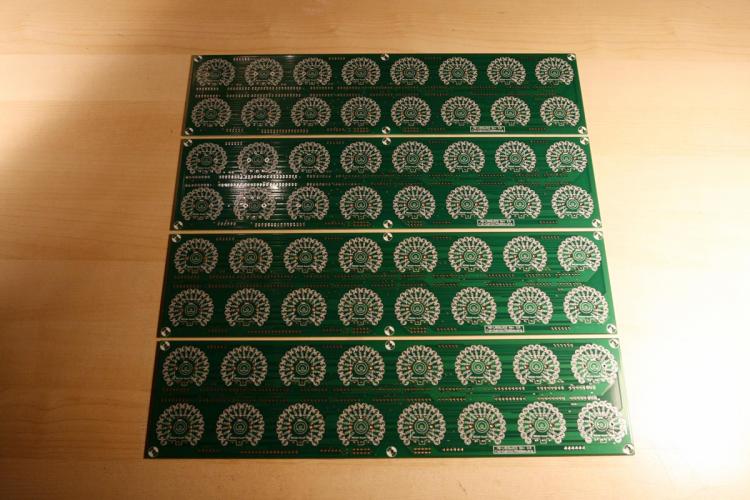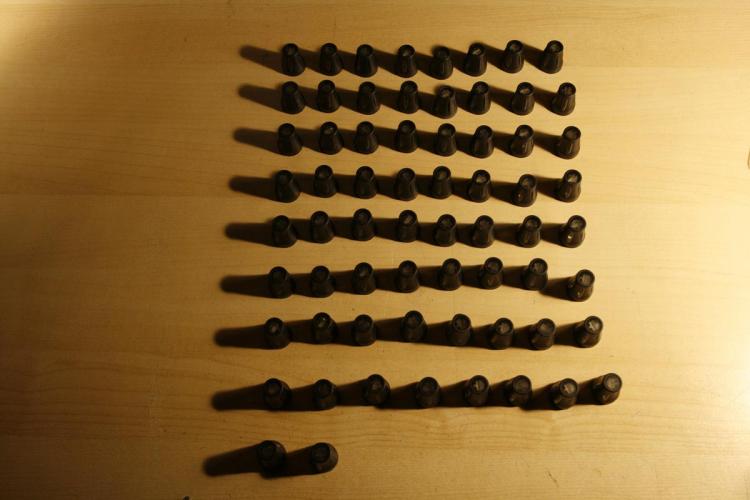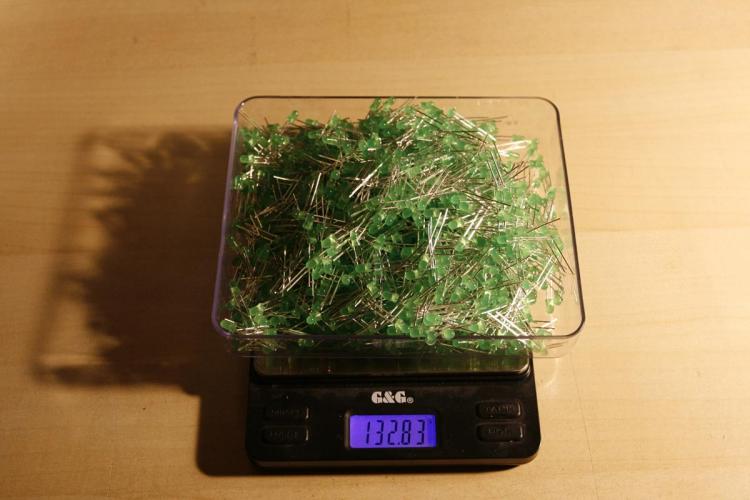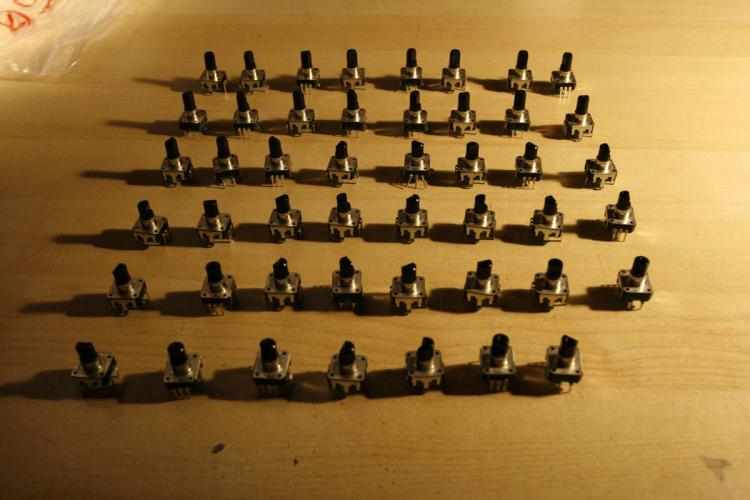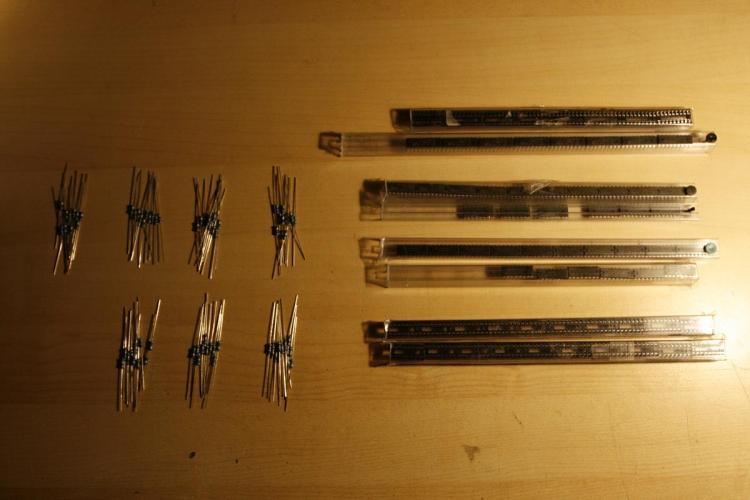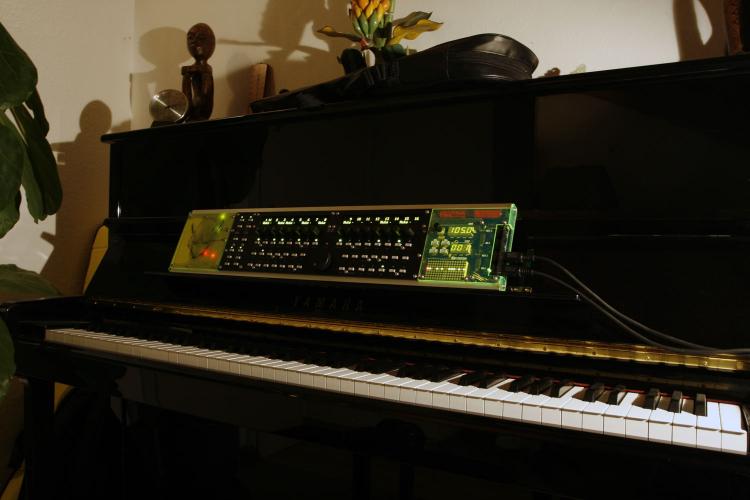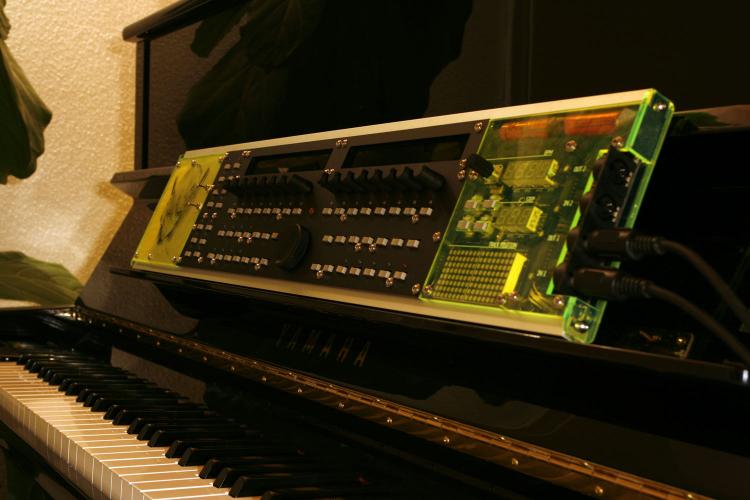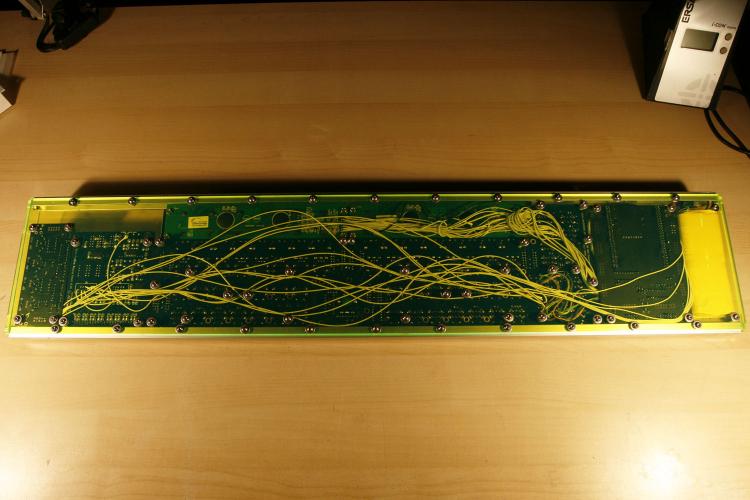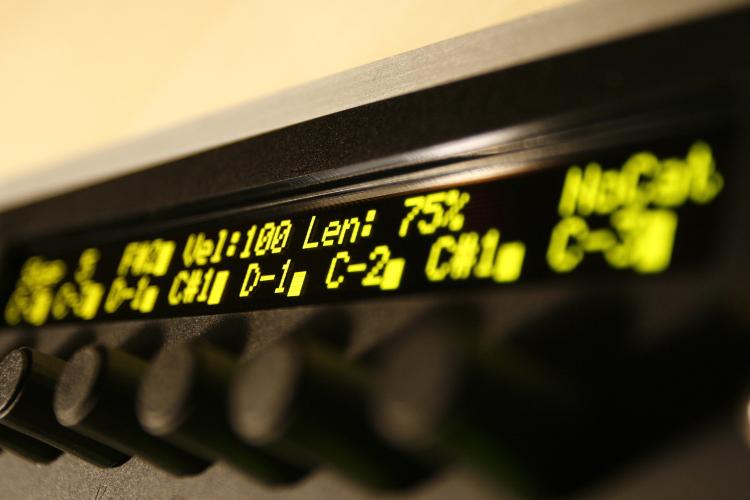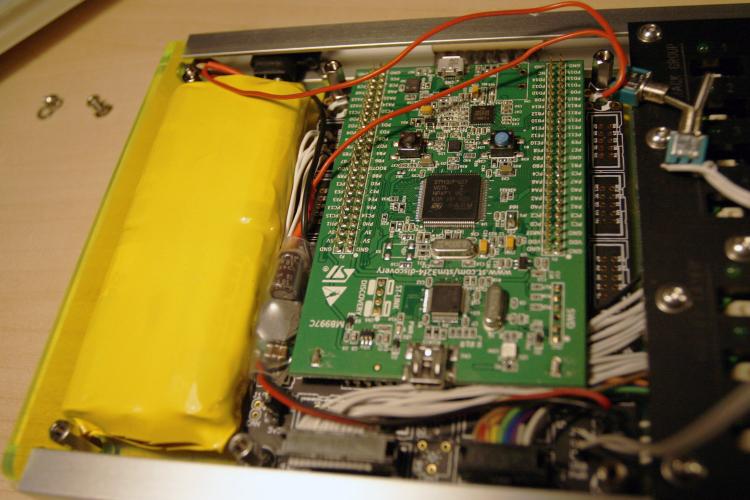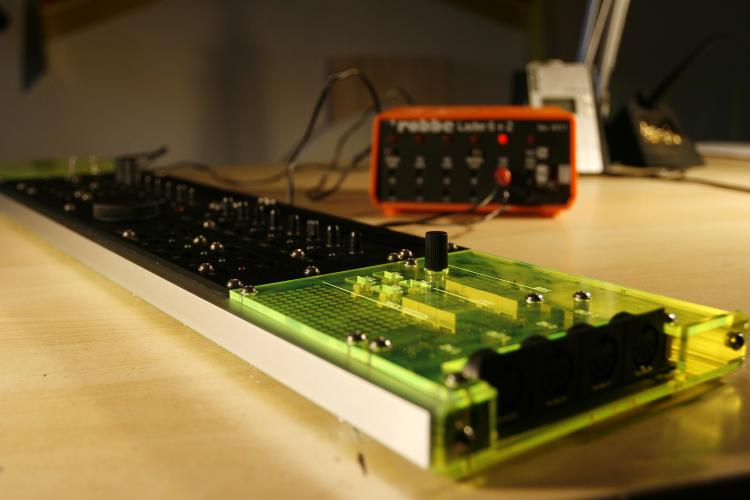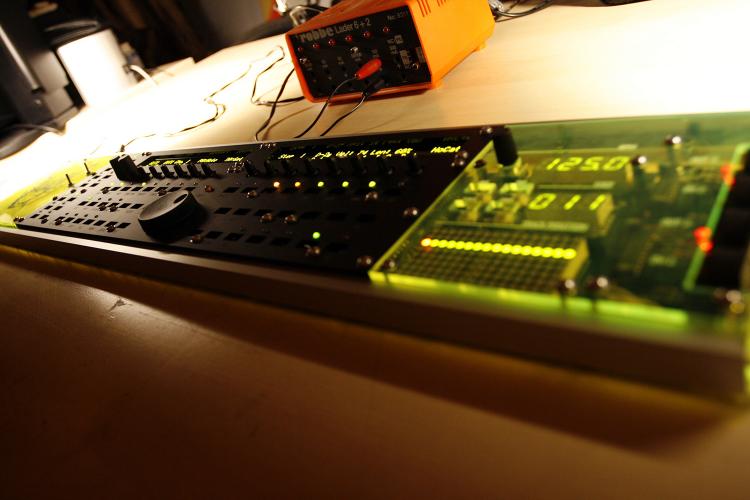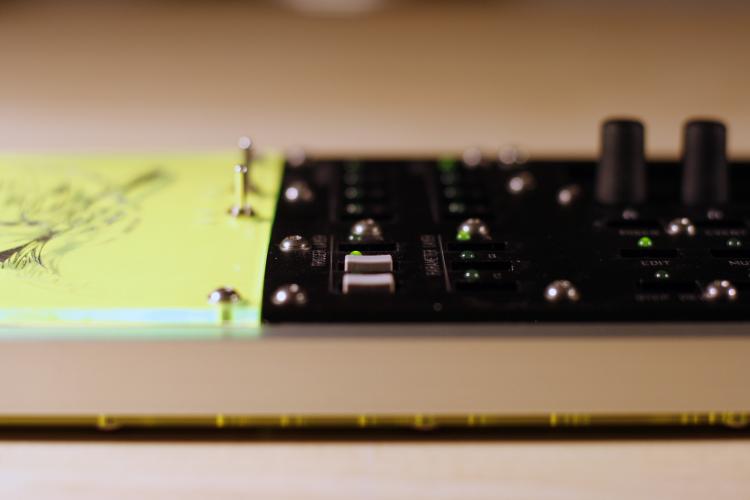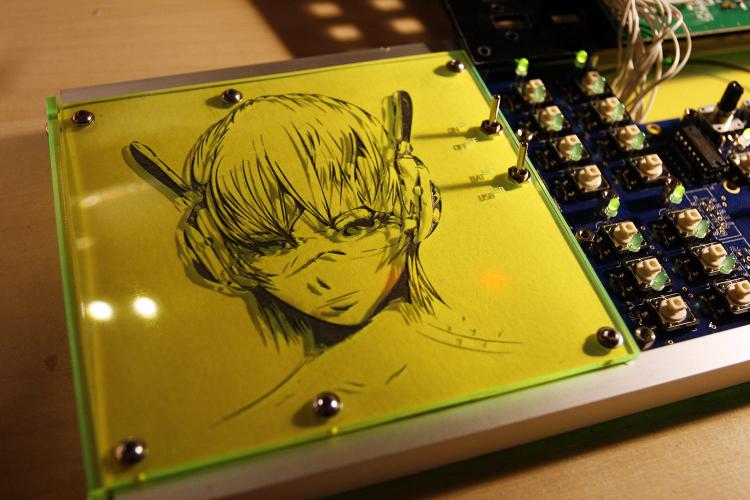-
Posts
3,633 -
Joined
-
Last visited
-
Days Won
36
Content Type
Profiles
Forums
Blogs
Gallery
Everything posted by Hawkeye
-
Ok, documenting the MIDIbox LEDring wares to be handed over to the next blinkinglights enthusiast :-) 4x LEDRing boards 8x2 64 + 2 spare Waldorf transparent knobs about 1200 green LEDs suitable for the LEDring boards (100 LEDs = ca 11 grams). Yes, i now sell these by the kilo :-) a bunch of pushable ALPS STEC 12mm encoders (only 47 pieces, need to buy a few more). Unfortunately they have different shaft lengths and they are 12mm (needs pinbending), so I'll sell them cheaply or make the purchase optional :-) and a bit of thru-hole hardware: 70pcs 47R (yes, that is the correct value for these LEDs in a 16x16 matrix) resistors. (6 spare) 8pcs ULN2803 + 8pcs 18pin sockets (these are not standard sockets for MIDIbox projects, so i include them :-)) 16pcs 74HC595 (output shift registers) 16pcs 74HC165 (input shift registers) (without 16pin sockets) Still needed: a few 100nF caps, some resistor networks, and IDC sockets to connect to the core... Calculating total price now and sending via PM :-) Many greets and enjoy, Peter
-
Yo Phat, I have 4 of Fairlightiis original 8x2 boards in stock, a bunch of pushable STEC12E08 12mm Alps encoders (need to be pinbent to fit in the 16mm slots!) and transparent Waldorf Knobs, > 1024 powerful enough green LEDs (for the 16x16 LEDmatrix), ULNs to boost those LEDs, chip sockets, matching resistors for the LEDs and most necessary shift registers available, that I am willing to let go. Basically, these are most parts necessary to build another Programma :-). I wanted to extend the Programma to double size, but this will probably not happen due to time (baby, awesome but time-intensive! :-) and space reasons. Selling only, if you take the whole pack. I'd accept keeping the encoders, if you want easier life by soldering in some 16mm ones :-) If you are interested, write me a PM, I will look up everything and sum it up, selling 1:1 for the original purchase prices, but you will save on shipping, as it comes from one source, only :-). Many greets! Peter
-

Mixed DIN/DOUT board -- clock and latch chaining?
Hawkeye replied to latigid on's topic in Testing/Troubleshooting
No problem :-). Probably within software, the output pins 13/Y5 (RC1 on J8/9 the STM32F4 board) and 14/Y4 (RC2 on J8/J9 ofthe STM32F4 board) of the '541 are switched in unison/at the same time, but I also have the strong feeling, one should not connect the RCs in the serial chain :-). Many greets, Peter -

Mixed DIN/DOUT board -- clock and latch chaining?
Hawkeye replied to latigid on's topic in Testing/Troubleshooting
Hm, that (and the lack of sleep ;-)) explains my confusion a few weeks back :-). RCs on J8/J9 do come from different 74HCT541 pins, but... while "beeping through" connections from the core to the SEQ CS, only 6 connections (single RC line) were needed to wire up the SEQ CS, but 7 connections (two RC lines, that are common on the SEQ CS board, but I did not know that then) to wire up the TPD :-). Does it have something to do with the maximum possible serial chain length? Wilba (SEQ CS PCB) connected the RCs, Ilmenator (TPD PCB) kept them separate... Does it make no difference or was it just a violation of well-established norms and standards? :-) Many greets, Peter -

The Flatsequencer (MBSEQ V4 with TPD, battery powered)
Hawkeye replied to Hawkeye's topic in MIDIbox SEQ
@TK: hehehe! Good idea! Especially the inflatable bit might boost inspiration! ;-) @EsotericLabs: cool, please do that! If you happen to find any 15mm x 10mm x 10mm *black* U-shaped aluminum profiles, please tell me :) @westlicht: yes, i used the same old 12mm pushable Alps encoders as used in previous projects, but while these encoders are the next best thing after sliced bread, certain precautions must be met: a) their pins need to be bent to fit in the 16mm encoder sockets. b) the center and the right pin need to be swapped (crossed with a wire). If you are happy to do that, check the photo tutorial :-). Parts number: Alps STEC12E08, you might get these cheap on ebay. Now, the build is finally complete, and the piano has a worthy and portable sequencer, that also got the gurls blessing. I added 2 more batteries, to enhance the runtime and boost the input voltage to the switching voltage regulator. And I might swap the silver aluminum profiles for black ones, if I can source them. And eliminate a few LEDs on the STM32F4 board, as they shine through the manga. But this is all of secondary priority, it works and I have to thank TK. and Wilba again for their great work! Many greets, Peter- 22 replies
-
- battery powered
- v4
-
(and 3 more)
Tagged with:
-

The Flatsequencer (MBSEQ V4 with TPD, battery powered)
Hawkeye replied to Hawkeye's topic in MIDIbox SEQ
That room is reserved for the new SEQ V4 Song Creativity Module™. TK. just needs to release it, he keeps all the goodies for himself! ;-) Hehe! :-) Many greets, Peter- 22 replies
-
- battery powered
- v4
-
(and 3 more)
Tagged with:
-

The Flatsequencer (MBSEQ V4 with TPD, battery powered)
Hawkeye replied to Hawkeye's topic in MIDIbox SEQ
Thx, y'all :-)! Good news: because it is nearly completed, I will stop spamming this forum thread, soon :-). EsotericLabs: cool! Make sure, you post some pics, if you follow that path! :-) An advantage of this method is, that you need not buy a case. A disadvantage is, that you have to work on the aluminum rails, but it is not difficult - and they are available in a lot of sizes (also higher than 15mm) for cheap. Shuriken: ah, the build list needs to be processed from top to bottom... the Anushri (thx for that again!) is probably due somewhen in 2017, given the little one does not interfere so much ;-). --- Here is a picture of the bottom panel of the unit. Most module interconnections are "spaghetti wired", as there was no room for proper connectors. But these wires are well protected behind the acrylics bottom cover. The top acrylics panels and the bottom panel are held together by > 2x50 screws and center hex spacers. In conjunction with the alu rails, this box is really stable, but one should invest in an ergonomic screwdriver ;-). Many greets, Peter- 22 replies
-
- battery powered
- v4
-
(and 3 more)
Tagged with:
-

The Flatsequencer (MBSEQ V4 with TPD, battery powered)
Hawkeye replied to Hawkeye's topic in MIDIbox SEQ
Thx :) Sauraen: the OLEDs (picture one) are the same Raystars as in Jbdivers thread: Great price on tme.eu, but should also be available on mouser. The displays look great and are highly recommended! :-) EsotericLabs: The exact dimensions of the case are 70cm x 15cm x 2.1cm, using cheap aluminum "U" profiles, with dimensions 10mm x 15mm (vertical side) x 10mm. Then there is a big acrylics baseplate and three acrylics top plates. Actually, I think that I bought the black center part from you last year, thx again! :-). The core is placed below the manga, it had to be soldered quite flat, with only 15mm of vertical space to work with :-). It may be a bit tight in there, but all fits, see picture two. There are switches for battery or usb power, a small switching regulator (inexpensive ubec from the rc hobby sector), a charge port and a cutout in the aluminum top profile for easy access to the sd card and the micro usb port. The battery is just a quickly soldered-together NiMh AA pack, 6 cells for now, but i found some available unused space above the tpd, might add two additional cells for more runtime later on. It can be charged with any NiCd/NiMh charger without risk of fire or other problems :-). Now, fitting the tactile switch caps. It will take some time, as each of them has to be modified a bit to fit, but sometimes easy, repetitive work is just what is needed to calm down ;-). Many greets, Peter- 22 replies
-
- battery powered
- v4
-
(and 3 more)
Tagged with:
-
Awesome! This adds a lot of interesting possibilities! Hopefully Andy preps up for the second batchrun of BLMs, soon! ;-) Many greets, Peter
-
Hi there, no problem, you can use fewer wires, as some connections on the 10-pin IDC connector are mirrored. For the "Flatsequencer" :-) I only connected 7 wires as direct cable spaghetti connection: VS, VD, SO, SI, SC, RC1, RC2. The pinout on the TPD mirrors the J8/J9 pinout on the STM32F4 board: When you examine the PCB traces on the TPD board, it becomes evident, what must be VS/VD. If i remember correctly, if you view the TPD board from the top and rotate it 90 degrees to the right and lay it next to the STM32F4 as pictured above, the connections should match 1:1. (Edit: when the SEQ CS is connected to the STM32F4, you can use a mutlimeter in resistance measurement mode on the core J8/J9 to find the respective matching output pins on J2 of the CS board). Many greets, Peter
-

The Flatsequencer (MBSEQ V4 with TPD, battery powered)
Hawkeye replied to Hawkeye's topic in MIDIbox SEQ
Thanks, TK! :-) Here are two more views: a) the unit charging, using an old retro 1980s NiCd charger b) and when turned on in battery mode The MIDI ports are actually a bit taller than the case, but that is not a problem... Still some parts are missing, but it is working alright :-) Many greets, Peter- 22 replies
-
- battery powered
- v4
-
(and 3 more)
Tagged with:
-

The Flatsequencer (MBSEQ V4 with TPD, battery powered)
Hawkeye replied to Hawkeye's topic in MIDIbox SEQ
Thanks, guys.... more pictures soon, as the build progresses! :-) Andy: there are button caps, these are just not standard and require a bit of labor to fit on the omron switches, but they have a perfect feeling! :-) Many greets and thanks for your comments! Peter- 22 replies
-
- battery powered
- v4
-
(and 3 more)
Tagged with:
-

Building a MIDIbox SEQ V4 (Wilba Control Surface) - Photo Tutorial
Hawkeye replied to Hawkeye's topic in Tips & Tricks
A small update to the encoder recommendation: In some cases, the Alps 12mm encoders may need to have the middle and right pins (when looked at from above) crossed and DETENTED1 does not work properly. This operation can be done easily by clipping of the metal pins and soldering two crossed wires. Norbim1 was totally right! The funny thing: No problems occur with the old LPC17 board. And it is quite usable with the STM32F4 board, but sometimes, the display "jumps back a step" after turning an encoder counterclockwise. Anyone, that has soldered in these encoders and is using DETENTED1 is encouraged to test it: In the main menu, scroll right with the menu encoder, then scroll left. After reaching the leftmost menu point, sometimes, the cursor will jump back to the second menu item. If this is the case, a little soldering action solves the problem! Sorry for the inconvenience! Bye, Peter- 35 replies
-
Ein kleines Update zu den 12mm Alps-Encodern: Mit dem LPC17 Core oder ohne TPD-Board läuft DETENTED1 absolut prima, aktuell hab ich einen STM32F4 Core mit TPD Board und dort läuft es zu 99%, aber manchmal wird ein Schritt zurückgesprungen. Das ist nicht wirklich schlimm, aber man merkt es, wenn man damit rumexperimientiert. Im Endeffekt ist daher die aktuelle Empfehlung: a) doch andere Encoder nehmen b) falls schon eingebaut, mit DETENTED1 testen, möglicherweise funktioniert alles zufriedenstellend c) im Zweifel doch den mittleren Pin und den rechten Pin kreuzen und neu verlöten (dauert ca 1 Minute pro Encoder, also auch nicht soo schlimm). Sorry für den Stress, ich update gleich das Phototutorial, in dem diese Encoder empfohlen werden. Ciao und viele Grüße, Peter
-
Hola, End of year holidays = build time ;-) Here is a new specialized "form factor" for a MBSEQ, that is based on Wilbas CS PCB and the new STM32F4 board. Of course, it involves a bit of DIY to achieve the flatness, some connections have to be soldered without IDC connectors, and U-shaped aluminum rails have to be cut, but no problem! :-) Tech specs: * "Slim and wide" MBSEQ V4, only 21mm high, about 70 cm wide * 40x2 OLEDs for high screen update speed and low power consumption * Pushable encoders for accelerated scrolling/note input * Battery powered for high mobility and no necessity to carry around a PSU for a jam session with friends * High quality omron tactile switches for a few million cycles (at least that is what they are advertised for) * Green transparent acrylics base and side panels for ambient light gathering and green beam emission :-) * Additional bling and functionality achieved with the TPD board :-) * Laser engraved Manga, that has been "inked" for a higher contrast :-). More pictures will be added, as the build progresses, but so far things are looking good! The battery is a 6 cell 2700mAh AA NiMh soldered pack, that can be recharged with a simple wall charger (the charge port is installed in the upper aluminum rail). A small integrated high-efficiency switching PSU converts the 6 - 9V from the battery pack down to a stable 5V. USB powered operation is optional and switchable. The battery actually lasts for many hours, i have not managed to drain it during the assembly test time, I guess it should be good for at least an evening of jamming, but maybe even 10 hours (current not measured, yet). Using NiMH and not LiPo batteries was a requirement, due to easiness of charging and battery safety. This unit was especially built for use on a MIDIfied piano. It fits perfectly on the central noteholder and after attaching just 2 midi cables, one is ready to jam :-). The amount of MIDI ports has been reduced to 4, as more is not necessary for that usecase, but an additinal four MIDI ports can be stacked on top (right side of the unit, see a picture, that is posted later on ;-)). If you are interested in the Formulor/Ponoko plans or have general build questions, say a word, and I will make them available publicly and give advice on how to build it. Hopefully, you are enjoying the report and maybe get some ideas for building a non-standard SEQ? :-) It is the best hardware sequencer on this planet and deserves some customization efforts to create a unique, personalized unit! :-) Many greets, Peter
- 22 replies
-
- battery powered
- v4
-
(and 3 more)
Tagged with:
-

ubuntu linux - make arm-none-eabi-gcc: error
Hawkeye replied to Phatline's topic in MIOS programming (C)
All references are local to the path stored, the binaries (missing cc1), the headers and so on... So, the missing include files were the final hint :) In the MIOS32 Toolchain docu page, the PATH setup is described correctly, dunno how that deeper PATH got into your setup http://www.midibox.org/dokuwiki/doku.php?id=linux_mios32_toolchain_core But for now, cheers and enjoy a cold one, you've earned it! ;-) Many greets, Peter -

ubuntu linux - make arm-none-eabi-gcc: error
Hawkeye replied to Phatline's topic in MIOS programming (C)
Ok, it is messed up, as it does not find the standard headers. I've looked into it a bit, can you try to adjust your PATH from PATH="/home/triggermatrix/mios32_toolchain/arm-none-eabi/bin:/usr/local/sbin:/usr/local/bin:/usr/sbin:/usr/bin:/sbin:/bin:/usr/games:/usr/local/games" To PATH="/home/triggermatrix/mios32_toolchain/bin:/usr/local/sbin:/usr/local/bin:/usr/sbin:/usr/bin:/sbin:/bin:/usr/games:/usr/local/games" ? -

ubuntu linux - make arm-none-eabi-gcc: error
Hawkeye replied to Phatline's topic in MIOS programming (C)
no problem! :) yes, cc1 is now linked/verknüpft :) can you now please make clean and make --trace again? Was there any progress? Do we now get past the previous point where "cc1 was missing"? Many greets, Peter PS: Shuriken: no problem either, I first thought about recommending that "ln -s" in /usr/bin, too :). -

ubuntu linux - make arm-none-eabi-gcc: error
Hawkeye replied to Phatline's topic in MIOS programming (C)
what is the result of type cc1 now? Sorry for all that inconvenience! :) Many greets, Peter -

ubuntu linux - make arm-none-eabi-gcc: error
Hawkeye replied to Phatline's topic in MIOS programming (C)
Ok! The current error is because of the softlink within /usr/bin, it links to the wrong compiler frontend plz try: rm /usr/bin/cc1 (this removes the problematic link) ln -s /home/triggermatrix/mios32_toolchain/lib/gcc/arm-none-eabi/4.7.4/cc1 /home/triggermatrix/mios32_toolchain/arm-none-eabi/bin/cc1 (this adds a link of the correct cc1 to your in-path toolchain directory. This should not be necessary, but somehow the crosscompiler gcc does not know where to find it otherwise). type cc1 (this should now output /home/triggermatrix/mios32_toolchain/arm-none-eabi/bin/cc1 and confirm, that cc1 is now in path and can be opened) then recompile. I have a feeling other errors will follow, as other binaries within the lib/gcc directory are needed. But we should get a different error at least and can fix that problem with a PATH extension maybe. Many greets, Peter -

ubuntu linux - make arm-none-eabi-gcc: error
Hawkeye replied to Phatline's topic in MIOS programming (C)
Another question, in the first post, you wrote, that the settings are set to MIOS32_FAMILY=LPC17xx MIOS32_PROCESSOR=LPC1769 MIOS32_BOARD=MBHP_CORE_LPC17 has this changed by now? Because it seems to be compiling for a STM32F4 target... Many greets! Peter -

ubuntu linux - make arm-none-eabi-gcc: error
Hawkeye replied to Phatline's topic in MIOS programming (C)
Ok! Can you ls -al /home/triggermatrix/mios32_toolchain/lib/gcc/arm-none-eabi/4.7.4 (the directory version number might be slightly different). Is there a "cc1" in this directory? Many greets, Peter -

ubuntu linux - make arm-none-eabi-gcc: error
Hawkeye replied to Phatline's topic in MIOS programming (C)
Ok, it is a little strange, as we are dealing with two types of errors: First one: arm-none-eabi-gcc: error: .ld: No such file or directory And now: arm-none-eabi-gcc: error trying to exec 'cc1': execvp: No such file or directory Creating the softlink in the /usr/bin directory linked in a compiler frontend not from the toolchain, but from the base system, so the very last errors regarding the wrong command line options are understandable - the /usr/bin/cc compiler does not understand the architecture settings. The "wanted" cc1 target should reside in your toolchain directory under lib/gcc/arm-none-eabi/4.7.4/cc1 (or a similar path, if you are using a slightly different version). Can you give us a listing of that directory? --- Whenever you execute arm-none-eabi-gcc this one should reside in your toolchain directory. To confirm that, enter type arm-none-eabi-gcc which lists the path of the executable, that will be loaded. If it is in the toolchain directory, it should automatically look for "cc1" in the respective directory. If it is not there, the toolchain installation might be incomplete. ---- I am personally not using linux, but a freebsd-based toolchain and therefore don't know for which platform the linux toolchain was made, if it was made for a 64bit platform, this might also be the reason (as you are using a 32-bit system) for these strange and different problems... Well, good luck! :-) Many greets, Peter -

ubuntu linux - make arm-none-eabi-gcc: error
Hawkeye replied to Phatline's topic in MIOS programming (C)
Hola and a happy new year! :-) Strange problem, could you rerun with a "make --trace" and copy & paste the region just above the error (not the full dump, that would be rather long ;-))? So we know, which exact command is being executed that causes the problem... Many greets! Peter -
Hi there and a happy new year! :) Possible: maybe... Amount of work: a lot! :) The question is: why? The STM32F4 boards are really inexpensive (~ 12-14 bucks), are widely available and "just work" :). Imho the best 32bit MIOS core evar! :). Many greets and have fun! Peter


